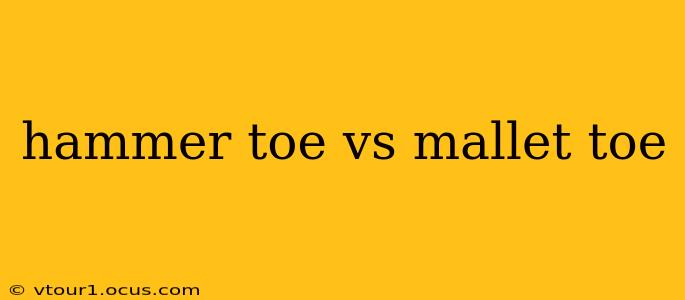Hammer toe and mallet toe are both deformities of the toes, causing them to bend abnormally. While they share similarities, understanding their key differences is crucial for proper diagnosis and treatment. This comprehensive guide will clarify the distinctions between hammer toe and mallet toe, addressing common questions and concerns.
What is a Hammer Toe?
A hammer toe is a deformity affecting the middle joint of the toe (the proximal interphalangeal joint, or PIP joint). This joint bends abnormally, causing the toe to resemble a hammer. The tip of the toe may point upward, while the middle joint bends downward. Hammer toe can affect any toe, but it's most common on the second, third, or fourth toes. The cause is often a muscle imbalance or poorly fitting shoes that continually squeeze the toes.
What is a Mallet Toe?
A mallet toe is similar to a hammer toe but affects the top joint of the toe (the distal interphalangeal joint, or DIP joint). In a mallet toe, only the tip of the toe bends downward, while the middle joint remains relatively straight. Like hammer toe, mallet toe can affect any toe, but it is most commonly seen on the smaller toes. Similar to hammer toe, ill-fitting footwear plays a significant role in its development.
What Causes Hammer Toe and Mallet Toe?
Both hammer toe and mallet toe share several common causes:
- Ill-fitting shoes: Shoes that are too tight, too narrow, or have high heels can put excessive pressure on the toes, leading to muscle imbalances and deformities.
- Muscle imbalances: Weakness or imbalance in the muscles of the foot can contribute to these conditions. This imbalance can be genetic or caused by other medical conditions.
- Arthritis: Conditions like rheumatoid arthritis can damage the joints in the toes and contribute to hammer toe and mallet toe development.
- Injury: Previous injuries to the toes can also lead to these deformities.
- Neuromuscular diseases: Conditions like cerebral palsy or Charcot-Marie-Tooth disease can also cause these toe deformities.
How are Hammer Toe and Mallet Toe Treated?
Treatment options for both hammer toe and mallet toe vary depending on the severity of the deformity and the individual's symptoms.
- Conservative Treatment: For mild cases, conservative treatment may be sufficient. This can include wearing properly fitting shoes with wider toe boxes, using toe separators or pads to straighten the toes, and performing exercises to strengthen the foot muscles.
- Orthotic Devices: Custom-made orthotics can help support the foot and correct the toe alignment.
- Surgery: If conservative treatment fails to improve the condition or if the deformity is severe, surgery may be necessary. Surgical procedures can involve tendon transfer, joint fusion, or even removal of part of the bone.
What are the Symptoms of Hammer Toe and Mallet Toe?
The primary symptom of both hammer toe and mallet toe is the visible bending of the toe. However, other symptoms can include:
- Pain: Especially when wearing shoes or engaging in activities that put pressure on the affected toe.
- Corns and calluses: The bent toe often rubs against the shoe, forming corns and calluses on the top of the toe joint.
- Inflammation: The affected joint can become inflamed and swollen.
- Limited range of motion: Difficulty bending and straightening the affected toe.
Can Hammer Toe and Mallet Toe Be Prevented?
While not always preventable, the risk of developing hammer toe and mallet toe can be minimized by:
- Wearing properly fitting shoes: Opt for shoes with ample space in the toe box and avoid high heels.
- Strengthening foot muscles: Regular stretching and exercises can improve foot muscle balance and strength.
- Seeking early treatment: Addressing any foot pain or abnormalities promptly can help prevent the progression of these conditions.
Are Hammer Toe and Mallet Toe the Same Thing?
While both hammer toe and mallet toe involve the bending of a toe, they are distinct conditions. Hammer toe affects the middle joint, while mallet toe affects the top joint. This difference in the affected joint necessitates different diagnostic approaches and may result in variations in treatment strategies.
This information is intended for general knowledge and informational purposes only, and does not constitute medical advice. Always consult with a qualified healthcare professional for any health concerns or before making any decisions related to your health or treatment.
